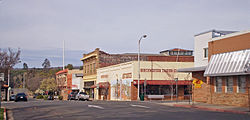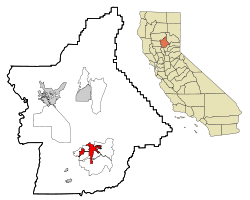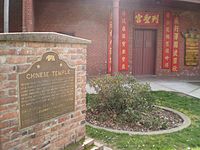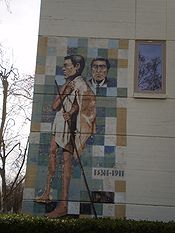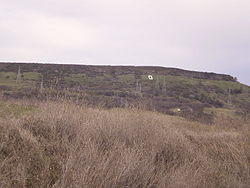- Oroville, California
-
City of Oroville — City — Historic Downtown Oroville Nickname(s): 'City of Gold' Location of Oroville in California Coordinates: 39°31′N 121°33′W / 39.517°N 121.55°WCoordinates: 39°31′N 121°33′W / 39.517°N 121.55°W Country  United States
United StatesState  California
CaliforniaCounty Butte Government – Mayor Steve Jernigan – State Senate Doug LaMalfa (R) – State Assembly Dan Logue (R) – U. S. Congress Tom McClintock (R) Area[1] – City 13.011 sq mi (33.701 km2) – Land 12.993 sq mi (33.653 km2) – Water 0.018 sq mi (0.048 km2) 0.14% Elevation 167 ft (51 m) Population (2010) – City 15,506 – Density 1,191.7/sq mi (460.1/km2) – Metro 48,000 (estimated) Time zone PST (UTC-8) – Summer (DST) PDT (UTC-7) ZIP codes 95940, 95965, 95966 Area code(s) 530 FIPS code 06-54386 GNIS feature ID 0277570 Website http://www.cityoforoville.org Oroville (formerly, Ophir City) is the county seat of Butte County, California. The population was 15,506 at the 2010 census, up from 13,004 at the 2000 census. The Berry Creek Rancheria of Maidu Indians of California is headquartered here.
Contents
History
Oroville is situated on the banks of the Feather River where it flows out of the Sierra Nevada onto the flat floor of the California Central Valley. It was established as the head of navigation on the Feather River to supply gold miners during the California Gold Rush.
The town was originally called Ophir City; the name was changed to Oroville when the first post office opened in 1854.[2]
Gold found at Bidwell Bar, one of the first gold mining sites in California, brought thousands of prospectors to the Oroville area seeking riches. Now under the enormous Lake Oroville, Bidwell Bar is memorialized by the Bidwell Bar Bridge, an original remnant from the area and the first suspension bridge in California (California Historical Landmark #314). In the early 20th century the Western Pacific Railroad completed construction of the all-weather Feather River Canyon route through the Sierra Nevadas giving it the nickname of "The Feather River Route". Oroville would serve as an important stop for the famous California Zephyr during its 20 year run. In 1983, this became a part of the Union Pacific Railroad as their Feather River Canyon Subdivision. A major highway, State Route 70, roughly parallels the railroad line through the canyon.
The Chinese Temple (CHL #770 and listed on the National Register of Historic Places is another monument to Oroville's storied past. Chinese laborers from the pioneer era established the Temple as a place of worship for followers of Chinese Popular Religion and the three major Chinese religions: Taoism, Buddhism, and Confucianism. The Chinese Temple and Garden, as it is now called, has an extensive collection of artifacts and a serene garden to enjoy.
Ishi, Oroville's most famous resident, was the last of the Yahi Indians and is considered the last "Stone Age" Indian to come out of the wilderness and into western civilization. When he appeared in Oroville around 1911, he was immediately thrust into the national spotlight. The Visitor's Center at Lake Oroville has a thorough exhibit and documentary film on Ishi and his life in society.
Archaeological finds place the northwestern border for the prehistoric Martis people in the Oroville area.[3]
- Train Tunnel Disaster October 7, 1965: http://www.facebook.com/ext/share.php?sid=55145174707&h=aFLu7&u=7HBLw
- 5.7 magnitude earthquake: August 1, 1975: http://www.johnmartin.com/earthquakes/eqpapers/00000052.htm
- In the early 1970s the Movie "The Klansman", starring Richard Burton, Lee Marvin and O.J. Simpson, was filmed in Oroville. The story took place in rural Mississippi and at the time Oroville looked a bit like the old South. Simpson was a great favorite with local citizens, handing out awards at the high school sports award banquet and making friends everywhere he went. Marvin and Burton, whose wife Elizabeth Taylor was sometimes in residence at a rented mansion, held down the bar at the Prospectors Village Motel. While Marvin stuck to drinking, Burton presented a "pre-engagement engagement ring" to the local Miss Pepsi Cola. Toward the end of the shoot a high school janitor heard that Burton was dallying with his wife, whereupon the janitor chased the movie star out of town.[4]
- U-2 Spy Plane Crash North of Oroville on January 31, 1980: http://www.blackbirds.net/u2/u2local.html
- U-2 Spy Plane Crash in front of Oroville Mercury-Register on August 7, 1996: http://www.blackbirds.net/u2/u2local.html
On June 1, 2011, a tornado rated at EF-2, struck northwest of Oroville, causing significant damage to a ranch and a garage.[5]
Geography
Oroville is situated at the head of navigation on the Feather River. The Yuba River flows into the Feather River near Marysville, California and these flow together to the Sacramento River. Geologically, Oroville is situated at the meeting place of three provinces: the Central Valley alluvial plain to the west, the crystalline Sierra Nevada to the SE and the volcanic Cascade Mountains to the north. It has a Mediterranean climate.
Oroville sits on the eastern rim of the Great Valley, defined today by the floodplains of the Sacramento River and its tributaries. Around Oroville these sediments are dominated by thick fans of Feather River sediments, but just east of this there is a thin, N-S band of late Cretaceous sediments. These sit on top of the Sierran basement, which beneath eastern Oroville comprise greenschist-facies metavolcanic rocks of Jurassic age, giving way to granites of the Sierra batholith to the east. These are manifestations of a vigorous island arc sequence, built out over an east-dipping subduction zone of mid- to late Mesozoic age. The gold veins lace this ancient arc, remobilized by Mesozoic shearing and intrusions of igneous rock. The crystalline foothills are locally overlain by a Cenozoic sequence of Eocene clean beach sands overlain by Neogene volcanics, including the Diamond Head-like profile of Table Mountain.
Local government
Fire department
The local fire department for the city of Oroville is the Oroville Fire Department.
Demographics
2010
The 2010 United States Census[6] reported that Oroville had a population of 15,546. The population density was 1,194.8 people per square mile (461.3/km²). The racial makeup of Oroville was 11,686 (75.2%) White, 453 (2.9%) African American, 573 (3.7%) Native American, 1,238 (8.0%) Asian, 56 (0.4%) Pacific Islander, 554 (3.6%) from other races, and 986 (6.3%) from two or more races. Hispanic or Latino of any race were 1,945 persons (12.5%).
The Census reported that 14,662 people (94.3% of the population) lived in households, 72 (0.5%) lived in non-institutionalized group quarters, and 812 (5.2%) were institutionalized.
There were 5,646 households, out of which 2,126 (37.7%) had children under the age of 18 living in them, 1,893 (33.5%) were opposite-sex married couples living together, 1,174 (20.8%) had a female householder with no husband present, 430 (7.6%) had a male householder with no wife present. There were 615 (10.9%) unmarried opposite-sex partnerships, and 33 (0.6%) same-sex married couples or partnerships. 1,699 households (30.1%) were made up of individuals and 718 (12.7%) had someone living alone who was 65 years of age or older. The average household size was 2.60. There were 3,497 families (61.9% of all households); the average family size was 3.22.
The population was spread out with 4,267 people (27.4%) under the age of 18, 1,969 people (12.7%) aged 18 to 24, 3,940 people (25.3%) aged 25 to 44, 3,417 people (22.0%) aged 45 to 64, and 1,953 people (12.6%) who were 65 years of age or older. The median age was 31.5 years. For every 100 females there were 93.7 males. For every 100 females age 18 and over, there were 91.8 males.
There were 6,194 housing units at an average density of 476.0 per square mile (183.8/km²), of which 2,423 (42.9%) were owner-occupied, and 3,223 (57.1%) were occupied by renters. The homeowner vacancy rate was 3.6%; the rental vacancy rate was 8.4%. 6,293 people (40.5% of the population) lived in owner-occupied housing units and 8,369 people (53.8%) lived in rental housing units.
2000
According to the United States Census Bureau, the city has a total area of 12.3 square miles (31.8 km²), of which, 12.2 square miles (31.7 km²) of it is land and 0.04 square miles (0.1 km²) of it (0.16%) is water.
As of the census[7] of 2000, there were 13,004 people, 4,881 households, and 2,948 families residing in the city. The population density was 1,061.4 people per square mile (409.9/km²). There were 5,419 housing units at an average density of 442.3 per square mile (170.8/km²). The racial makeup of the city was 77.2% White, 4.0% Black or African American, 3.9% Native American, 6.3% Asian, 0.3% Pacific Islander, 2.8% from other races, and 5.4% from two or more races. 8.3% of the population were Hispanic or Latino of any race.
There were 4,881 households out of which 33.9% had children under the age of 18 living with them, 36.4% were married couples living together, 18.9% had a female householder with no husband present, and 39.6% were non-families. 33.2% of all households were made up of individuals and 14.5% had someone living alone who was 65 years of age or older. The average household size was 2.50 and the average family size was 3.19.
In the city the population was spread out with 30.1% under the age of 18, 10.3% from 18 to 24, 25.8% from 25 to 44, 19.2% from 45 to 64, and 14.7% who were 65 years of age or older. The median age was 33 years. For every 100 females there were 95.8 males. For every 100 females age 18 and over, there were 90.7 males.
The median income for a household in the city was $21,911, and the median income for a family was $27,666. Males had a median income of $28,587 versus $21,916 for females. The per capita income for the city was $12,345. About 16.2% of families and 23.1% of the population were below the poverty line, including 39.3% of those under age 18 and 8.9% of those age 65 or over.
Points of interest
- The Oroville Dam, perhaps Oroville's most famous site, is one of the 20 largest dams in the world, the largest earth filled dam in the US, as well as the tallest dam in the US. This dam is 770 feet (235 m) tall and 6920 feet (2109 m) long, and it impounds Lake Oroville, which has a capacity of 3,500,000 acre feet (4.3 km3) of water, making it the second largest reservoir in California. This is one of the most important parts of the California State Water Project (see also the Central Valley Project, a Federal undertaking). Both systems move water from water-rich Northern California to water-poor Southern California. This facility is operated by the California Department of Water Resources which is undergoing contract renewal with the City of Oroville and Butte County. The state has not paid any taxes on this facility nor developed the lake for recreation as originally promised which have been a bone of contention with the local government and residents.
- The Mother Orange Tree, located in Oroville, California, is the oldest of all Northern California orange trees.
- The fish hatchery located on Table Mtn Blvd just at the river. Tours for schools and individuals available.
- Riverbend Park on Montgomery street right off Hwy 70. Boat access to the river as well as fishing, disc golf, running and walking trails, river-beach, and water fountains to play in on hot days.
- Bedrock Park - swimming and fishing in the Feather River. Picnic areas. Located on the Feather River at the North end of Feather River Blvd.
- Brad Freeman Bike Trail - 41-mile (66 km) bike trail running along the Feather River up to the Dam back down through the city then out to the forebay and afterbay.
- Chinese Temple - built in 1863 by members of the Chinese Popular Religion.
Nearby attractions
- North and South Table Mountain - two volcanic plateaus located 3 miles (4.8 km) outside of Oroville. Home to vernal pools, mine shafts, spring wildflowers, ancient basalt flows, and seasonal waterfalls.
- Feather Falls - 6th highest waterfall in the U.S. Home to the ladybug migration.
- Bald Rock - granite batholith located in the Plumas National Forest.
- Lake Oroville State Recreation Area - a large area of lakeshore, forest, streams, hiking, biking, and horse trails located along the shoreline of Lake Oroville.
- Thermalito Afterbay - manmade resevour located just west of Oroville. Good for boating, hunting, and fishing.
- The Mother Orange Tree - The first orange tree planted in California
- Thermalito Forebay - small manmade resevour located just off Highway 70. Good for swimming, boating, and wildlife viewing.
- Oroville State Wildlife Area - a small area of protected wetland on the Feather River near Thermalito Diversion Pool. Area known for hunting and birdwatching.
Commerce and culture
Recently, as Chico has grown as a regional commercial giant, more people have been drawn to Oroville for close shopping, and lower property prices. It has been speculated that Oroville has undergone more construction of homes in the last four years than it has in the last 30 before it. A possible reason for this could be that the skyrocketing of property values in the San Francisco Bay Area has caused migration of new families. Oroville is also home to a considerable amount of ethnic Hmong. The Hmong migrated from Southeast Asia, especially from the country Laos, after the Vietnam War. The Hmong were allies of the American forces during the Vietnam War, many were recruited to help fight the Communist forces in Laos and Vietnam. Thus the Hmongs were given political asylum after the fall of Saigon to the Communist in 1975. Every year there is an annual festival during autumn which was originally a harvest festival but now called the New Year celebration. Ethnic Hmong make up 4.8% of Oroville's population, one of the larger communities in the north state. In the 1950s, a community of Romanians migrated from Europe, with 560 still there today. Nearby Indian reservations led to a surge in the Native American population, measured at 6.7% of the population in the 2000 census, but may be as high as 12%. The largest tribal group is the local Maidu. The world's largest museum of Maidu culture is located in Oroville East, at the Lookout Museum.
The 2008 cost of living index in Oroville was 79.0 (low, U.S. average is 100).
- The Oroville Municipal Airport is located south of State Route 162 west of State Route 70 at 39°29′19″N 121°29′19″W / 39.48861°N 121.48861°W.
- The Berry Creek Rancheria (Tyme Maidu Tribe) has tribal government offices listed on Tyme Way off State Route 162 with an approximate latitude/longitude of 39°30′08″N 121°30′16″W / 39.50222°N 121.50444°W.
- The State of California, Office of Statewide Health Planning and Development defines Oroville Hospital as a General Acute Care Hospital in Oroville with a Level III Trauma Center and Basic emergency care as of 08/22/2006. The facility is located near (NAD83) latitude/longitude of 39.5048594605 degrees N, -121.542808921 degrees W.
- This Is Oroville, a novelty song recorded and released as a 45 rpm single in 1987 by local teacher Steve Herman, is generally considered to be among the more popular California 'city songs.'
Top employers
According to the City's 2008 Comprehensive Annual Financial Report, the top employers in the city are:[8]
# Employer # of Employees 1 County of Butte 2,384 2 Oroville Hospital 1,233 3 Pacific Coast Producers 725 4 Gold Country Casino 520 5 Sierra Pacific Industries 135 6 Currier Square 127 7 City of Oroville 119 8 The Home Depot 105 9 Roplast Industries 103 10 RCBS 96 Education
The Oroville Union High School District includes all of the greater Oroville area, including some neighborhoods that are not within the city limits. The District includes two traditional high schools, Las Plumas High School and Oroville High School, and Prospect High School, which functions as a continuation school. The city also has an Adult School, Oroville Adult School.
The Oroville Elementary School District includes five primary schools and two middle schools, Central Junior High School and the recently-opened Ishi Hills.
There are also many small rural school districts in the surrounding area.
Higher educational opportunities are found at Butte Community College, just north of town, and at nearby California State University, Chico.
Oroville Elementary School District
Elementary
- Bird Street Elementary
- Oakdale Heights Elementary
- Ophir Elementary
- Stanford Avenue Elementary
- Wyandotte Avenue Elementary
Middle Schools
- Central Middle School
- Ishi Hills Middle School
- Nelson Avenue Middle School
Oroville Union High School District
High Schools
- Oroville High School
- Las Plumas High School
- Prospect High School
- Challenge Charter High School (Closed)
Higher education
- Oroville Adult School
- California State University, Chico (in Chico, 24 miles (39 km) northwest of Oroville)
- Butte Community College
- Northwest Lineman College
Notable residents
- Ishi, last surviving member of the Yahi Native American Tribe
- Isaac Austin, professional basketball player
- Sean Becker,[9] Sprint Car racer
- Shawn Bias, Professional Mixed Martial Arts fighter and former Palace Fighting Championship feather weight belt holder
- Kevin Brown, professional baseball player for the Milwaukee Brewers in the early 1990s
- Bobby Chacon, two time world boxing champion
- Erle Stanley Gardner, author of the Perry Mason novels
- Josh Hinkle, professional Mixed Martial Arts fighter currently holds a welterweight belt in IFC
- The Marcy Brothers, an American country music trio
- Marilyn Nash, actress and casting director[10]
- Gary Nolan, professional baseball player
- Adolphus Frederic St. Sure, Federal Judge
- Chuck Yeager, the first man to break the sound barrier
- Robert H. Young, Korean War Medal of Honor recipient
Media
Oroville is home to KRBS-LP, a low power community radio station owned and operated by the Bird Street Arbor Day Media Project. The station was built by numerous volunteers from Oroville and around the region in April 2002 at the second Prometheus Radio Project barnraising. KRBS broadcasts music, news, and public affairs to listeners at 107.1FM.
Superfund sites
Oroville has three designated superfund cleanup sites, two of which have been cleaned up and delisted: a Koppers Co. wood treatment plant, a Louisiana Pacific sawmill, and the Western Pacific railyard.
The Koppers Co. plant was listed on September 21, 1984 for pentachlorophenol (PCP), dioxin, furan, polycyclic aromatic hydrocarbon (PAH), and heavy metals (copper, chromium, and arsenic) contamination due to chemicals spilled on unpaved areas.[11][12]
The Louisiana-Pacific sawmill was listed on June 10, 1986 for pentachlorophenol PCP, dioxin, furan, heavy metals (arsenic, boron, and copper), and polycyclic aromatic hydrocarbon (PAH) contamination. Following remediation, the site was delisted on November 21, 1996. The sawmill was shut down in 2001.[13][14]
The Western Pacific Railroad yard was listed on August 30, 1990 for volatile organic compound (VOC) and heavy metals (arsenic, lead, and chromium) contamination. Following remediation, the site was delisted on August 29, 2001.[15][16]
Sister cities
 - Salem, Massachusetts (USA) 2007[17]
- Salem, Massachusetts (USA) 2007[17]
References
- ^ U.S. Census
- ^ Durham, David L. (1998). California's Geographic Names: A Gazetteer of Historic and Modern Names of the State. Quill Driver Books. p. 288. ISBN 9781884995149.
- ^ Brauman, Sharon K. (2004-10-06). "NORTH FORK PETROGLYPHS". ucnrs.org. http://sagehen.ucnrs.org/CSFRS/petros.htm. Retrieved 2008-08-15.
- ^ The Klansman at the Internet Movie Database
- ^ http://www.sacbee.com/2011/06/01/3668954/damage-assessed-from-tornadoes.html Sacramento Bee
- ^ All data are derived from the United States Census Bureau reports from the 2010 United States Census, and are accessible on-line here. The data on unmarried partnerships and same-sex married couples are from the Census report DEC_10_SF1_PCT15. All other housing and population data are from Census report DEC_10_DP_DPDP1. Both reports are viewable online or downloadable in a zip file containing a comma-delimited data file. The area data, from which densities are calculated, are available on-line here. Percentage totals may not add to 100% due to rounding. The Census Bureau defines families as a household containing one or more people related to the householder by birth, opposite-sex marriage, or adoption. People living in group quarters are tabulated by the Census Bureau as neither owners nor renters. For further details, see the text files accompanying the data files containing the Census reports mentioned above.
- ^ "American FactFinder". United States Census Bureau. http://factfinder.census.gov. Retrieved 2008-01-31.
- ^ City of Montebello CAFR
- ^ http://www.hammerdownusa.com/BeckerSean.htm
- ^ "Actress Marilyn Nash dies, Starred with Chaplin in 'Monsieur Verdoux'". Variety Magazine. 2011-10-14. http://www.variety.com/article/VR1118044450?categoryid=13&cs=1&cmpid=RSS%7CNews%7CLatestNews. Retrieved 2011-10-16.
- ^ "NPL Site Narrative for Koppers Co., Inc. (Oroville Plant)". National Priorities List. United States Environmental Protection Agency. February 24, 2006. http://www.epa.gov/superfund/sites/npl/nar1560.htm. Retrieved 2007-08-10.
- ^ "Koppers Industries Inc. (Oroville Plant)". Region 9: Superfund. United States Environmental Protection Agency. http://yosemite.epa.gov/r9/sfund/r9sfdocw.nsf/2e3c0ceec080b048882573290078b56a/028690d5578028d888257007005e941d!OpenDocument. Retrieved 2007-08-10.[dead link]
- ^ "NPL Site Narrative for Louisiana-Pacific Corp.". National Priorities List. United States Environmental Protection Agency. February 24, 2006. http://www.epa.gov/superfund/sites/npl/nar947.htm. Retrieved 2007-08-10.
- ^ "Louisiana-Pacific Corp.". Region 9: Superfund. United States Environmental Protection Agency. http://yosemite.epa.gov/r9/sfund/r9sfdocw.nsf/2e3c0ceec080b048882573290078b56a/0295e800790aa78688257007005e9442!OpenDocument. Retrieved 2007-08-10.[dead link]
- ^ "NPL Site Narrative for Western Pacific Railroad Co.". National Priorities List. United States Environmental Protection Agency. February 24, 2006. http://www.epa.gov/superfund/sites/npl/nar1560.htm. Retrieved 2007-08-10.
- ^ "Western Pacific Railroad Co.". Region 9: Superfund. United States Environmental Protection Agency. http://yosemite.epa.gov/r9/sfund/r9sfdocw.nsf/2e3c0ceec080b048882573290078b56a/5bffbf92efa932bd88257007005e93f4!OpenDocument. Retrieved 2007-08-10.[dead link]
- ^ Chico considers establishing permanent sister city guidelines - Chico Enterprise Record
External links
- City of Oroville
- Downtown Oroville
- Oroville Area Chamber of Commerce
- Oroville Dam
- Lake Oroville
- The Oroville Mercury-Register (Newspaper of Oroville)
- KRBS Low Power Community Radio
Municipalities and communities of Butte County, California Cities and towns CDPs Bangor | Berry Creek | Butte Creek Canyon | Butte Meadows | Butte Valley | Cherokee | Clipper Mills | Cohasset | Concow | Durham | Forbestown | Forest Ranch | Honcut | Kelly Ridge | Magalia | Nord | Oroville East | Palermo | Rackerby | Richvale | Robinson Mill | South Oroville | Stirling City | Thermalito | Yankee Hill
Unincorporated
communitiesAnita | Barber | Big Bar | Big Bend | Blavo | Brush Creek | Camp Eighteen | Cana | Centerville | Chapmantown | Craig | Cresta | Dayton | Deadwood | DeSabla | Dodge Place | Dodgeland | East Biggs | East Gridley | Elsey | Esquon | Fagan | Feather Falls | Helltown | Hughes Place | Hurleton | Inskip | Irish Town | James | Jonesville | Junction House | Kister | Kramm | Lomo | Lovelock | Lumpkin | Mayaro | Merrills Landing | Merrimac | Mineral Slide | Nelson | Nelsons Crossing | Nimshew | Oak Grove | Old Forbestown | Oregon City | Oroleve | Oroville Junction | Paradise Pines | Parkhill | Peachton | Pentz | Poe | Powellton | Pulga | Ramada | Rancho Llano Seco | Riceton | Richardson Springs | Robinsons Corner | Roble | Rogerville | Shippee | Stirling Junction | Sunnyslope | The Pines | Toadtown | Vista Robles | Wicks Corner | Wyandotte
Ghost towns Appleton | Avon | Bagdad | Bauka | Bayu | Berdan | Bidwell | Bidwell's Bar | Big Ripples | Blinzing | Bloomer | Brush | Butte Creek | Center Ville | Chandon | Channel | Chardon | Clear Creek | Colbys Landing | Coutolenc | Craig | Crouch | David | Dawlytown | Diamondville | Dredge | Enterprise | Eskini | Evans | Evansville | Flea Valley | Gimbal | Gold Lake | Greenland | Gridley Colony Number One | Gridley Colony Number Two | Hamilton | Haselbusch | Hawk Ravine | Hokomo | Holhoto | Honcut City | Hume | Hylandville | Intake | Isaiah | Johnson | Kalkalya | Kulaiapto | Land | Las Plumas | Lava Beds | Long's Bar | Lorraine | Losee | Luce | Lynchburg | Martinsburgh | McKay Meadow | Michopdo | Mill City | Millers Ranch | Mortimer | Moseley | Mulberry | Neals Diggins | Nelson Bar | New Blinzing | Oak Arbor | Ololopa | Omit Bar | Optimo | Oregon Bar | Orloff | Ostrander | Otaki | Pacific Heights | Paki | Paradise Flat | Phillips Corner | Pipers | Platts | Pond | Potter's Bar | Powellton Meadow | Quartz | Richland | Rio Seco | Rock Creek | Savona | Soto | South Fork | Speedway | Stanwood | Summit | Sundale | Sunusi | Swayne | Swedes Flat | Sycamore Crossing | Tadoiko | Taikus | Tarr's Ranch | Tilden | Tolle's Old Diggings | Totoma | Tsuka | Virginia Mills | Wagners | Wagstaff | Ward | West Branch | Whiskey Flat (east) | Whiskey Flat (west) | Yankee Flat | Yauko | Yuman
California county seats Consolidated city-county Municipalities Alturas | Auburn | Bakersfield | Colusa | Crescent City | El Centro | Eureka | Fairfield | Fresno | Hanford | Hollister | Jackson | Lakeport | Los Angeles | Madera | Martinez | Marysville | Merced | Modesto | Napa | Nevada City | Oakland | Oroville | Placerville | Red Bluff | Redding | Redwood City | Riverside | Sacramento | Salinas | San Bernardino | San Diego | San Jose | San Luis Obispo | San Rafael | Santa Ana | Santa Barbara | Santa Cruz | Santa Rosa | Sonora | Stockton | Susanville | Ukiah | Ventura | Visalia | Willows | Woodland | Yreka | Yuba City
CDPs Bridgeport | Downieville | Independence | Mariposa | Markleeville | Quincy | San Andreas | Weaverville
Categories:- Incorporated cities and towns in California
- Cities in Butte County, California
- County seats in California
- Oroville, California
- Superfund sites
Wikimedia Foundation. 2010.

